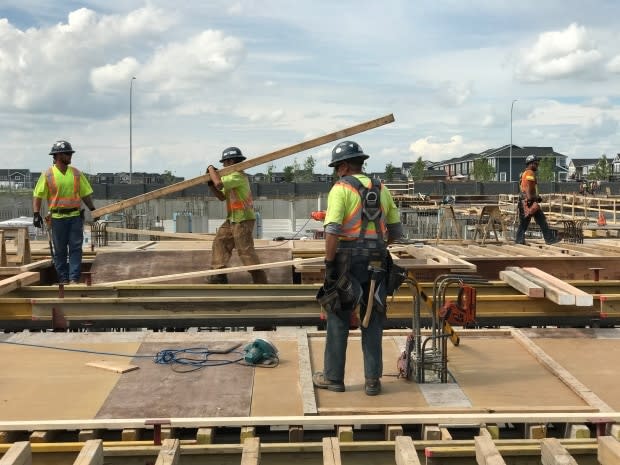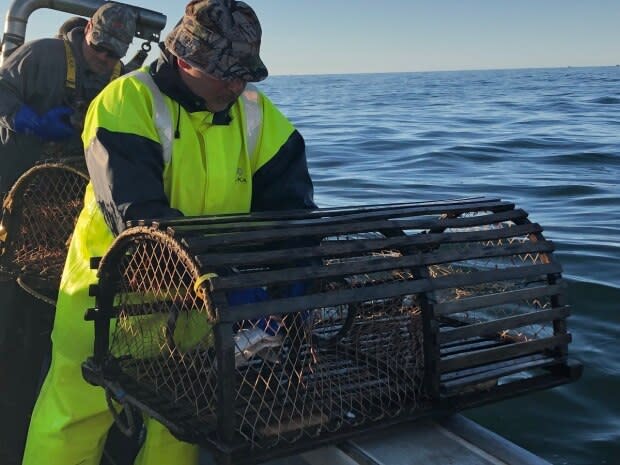Employers to get break on WorkSafeNB premiums in 2021
New Brunswick employers are expected to get a break on the premiums they pay to cover benefits for injured workers next year, says the head of WorkSafeNB.
The projected average assessment rate for 2021 is between $2.15 and $2.20 per $100 of payroll, said president and CEO Doug Jones.
That's down from $2.40 in 2020.
A decrease in the number of accidents has helped reduce costs, said Jones. New Brunswick recorded its lowest level of injury frequency in the past 10 years.
"That's just a really great story," he said. "It means that the workplaces are getting safer and safer."
Jones was to present the 2019 year-end results during a virtual annual general meeting Wednesday.
The lost-time injury frequency rate — or the number of accidents in a year per 100 full-time equivalent employees — for assessed employers, which is mostly the private sector, dipped to 1.3 in 2019, from 1.4 in 2018, he said.
For self-insured employers, which is mostly the public sector, it dropped to 3 from 3.7.
And for all employers combined, it decreased to 1.5 from 1.7.
There were 14 fatalities in 2019, which is a "huge drop" from the 28 in 2018 and lower than the 16 in 2017, but "still too many," said Jones.
"Any time you have any fatality it's just horrible. So we have to continue to focus on health and safety and stop those tragic, tragic accidents."
Impact of COVID-19 on numbers unclear
So far this year, all of these numbers are down "considerably," he said.
The lost-time injury frequency rate for assessed employers is 1.0, for self-insured employers it's 2.3, and for all employers combined, it's 1.2.
The number of fatalities year-to-date is three.

"What is difficult to really determine though is how much of this improvement is due to good safety behaviours and how much of it is due to how the workplaces have changed so much during the COVID times," said Jones.
Many businesses were forced to close during the pandemic, which began in March, while many others have their employees working from home.
"So [we're] really glad to see the numbers declining, it means less people are getting hurt. But it's really hard to interpret what those numbers really mean, given all the changes with COVID going on."
2 approved COVID claims
WorkSafeNB has accepted two claims related to COVID-19 to date, said Jones.
Both are individuals who work in health care and contracted the respiratory disease, he said.
Seven or eight other claims from health-care workers who also developed COVID are pending.
Jones attributed the low number of COVID claims to the province's geography and population density, the government's early action closing borders and schools, and the positive response from New Brunswickers.
A second wave of COVID is anticipated in the fall with potential overlap with seasonal influenza and other seasonal respiratory illnesses.
$312M net income ends 4 years of losses
Jones said Jan. 1 to Dec. 31, 2019, was a period of exceptional change at WorkSafeNB, as the organization adopted and acted upon the recommendations of the auditor general, as well as those of a task force on WorkSafeNB.
In addition, legislation enacted in December 2018 addressed two key issues that had been driving workers' compensation claims costs higher. It clarified that the intent of the workers' compensation system is to compensate for work-related injuries only, and policy deference was returned to WorkSafeNB's board of directors.
Some of the financial highlights for the year include:
Net income increased to $311.7 million, compared with a net loss of $271.5 million in 2018.
The return on investment of the accident fund was 14 per cent, compared with 1.3 per cent in 2018.
The accident fund's funded ratio improved to 105.1 per cent in 2019, from 85.3 per cent in 2018.
The valuation of benefit liabilities were reduced by $71 million, the first reduction following four years of significant increases that had totalled $626 million.
"It is remarkable," Jones said of the organization's improved financial position. About $100 million of the increase in revenue came from the increase in employer rates, he said.
Wait until 1st payment too long
One 2019 metric WorkSafeNB was "not happy … at all with" was how long it took to get a first payment to an injured worker following their workplace injury, said Jones.
It took an average of 39 days, up from 28 in 2018 and 26 the year before.
"That's one where we actually wanted to do a much better job," he said. "And in 2019, it went the other way. We had a lot of change going on and it really impacted our processes and extended it."
But as of the end of June 2020, the average is back to the 2017 number of 26 days, said Jones.

And he's confident a new application form launched last Friday for benefits and to report an injury/illness will get claims in faster, lead to faster decisions and get payments out to injured workers even faster.
The previous process, where both the employer and worker had to fill out the form together, was "pretty clunky," he said. "You had to fax things in and we were always waiting for information."
A team has been working on the changes for the last couple of months, based on a recommendation from the auditor general. Now the employer and worker can fill out forms separately online.
Was 'lagging' on return to work
The average claim duration also increased in 2019 to 269 from 247. Jones said post-traumatic stress disorder cases account for much of that.
"So that's a focus for us right now — what's the best type of treatment that we can provide to our injured workers that have suffered PTSD?"
Two areas where WorkSafeNB was "lagging the pack" and wanted to make some "substantial improvements" were the percentage of workers returned to work within 26 weeks and the percentage of workers returned to work within two years.
It's roughly "middle of the pack" compared to its peers across the country for the percentage of workers returned to work within 26 weeks at 79 per cent, up from 73 per cent, said Jones.
"We still have work to do there, and I'm confident we're going to see more improvements there through 2020."
For the percentage of workers returned to work after two years, "best in class" would be 98 per cent, and a couple are even 99 per cent, he said. "But to go from 94 to 96 [per cent], that's really improvement there in a year."
Fishing vessels not considered a workplace
Another area New Brunswick is lagging behind the rest of the country in is that its commercial fishing vessels are not considered a place of employment under the Occupational Health and Safety Act, even though it's "quite a dangerous industry," said Jones.
There were 17 fatalities in commercial fishing across Canada in 2018, he said. New Brunswick statistics were not immediately available.
Last year, WorkSafeNB representatives travelled across the province to consult with stakeholders about a proposal to include fishing vessels as a workplace.
They met face-to-face with "several hundred" individuals, including union representatives and fishing association officials, said Laragh Dooley, executive director of corporate communications.

Eighty-seven per cent of the respondents were in favour of a proposal, she said. Dooley could not immediately provide the number of respondents.
"It was certainly smaller than the number of individuals we presented to, but I did attend the majority of in-person sessions and for the most part, the meetings were very positive, productive meetings," she said in an email.
WorkSafeNB also launched a personal floatation device awareness campaign for the industry because many fishers believed they were bulky and hard to work around, but the technology has changed significantly over the years.
3 board vacancies
The projected average assessment rate for 2021 is "just guidance" for employers for now, said Jones. WorkSafeNB's actuaries will finalize the premium for the board around September, he said.
"But right now, they're saying it's looking like it'll be in this range," of between $2.15 and $2.20 per $100 of payroll.
The premium was $1.11 in 2016, $1.48 in 2017, $1.70 in 2018 and $2.65 in 2019.
Individual employer rates are calculated based on the risk and performance of the industry in which an employer is grouped, as well as an employer's own accident experience.
WorkSafeNB handles about 5,500 lost-time claims annually and 5,600 medical aid only claims annually.
It serves more than 15,000 employers at 26,600 workplaces and roughly 347,000 workers.
Construction, retail and health care represent the largest sectors.
Small businesses, with three to 12 full-time employees, represent about 81 per cent of the employers.
Medium-sized businesses, with 12-55 full-time employees, represent about 16 per cent of the employers, while large businesses with more than 55 full-time employees, represent about three per cent.
The WorkSafeNB 11-member board of directors has three vacancies.
Interviews are underway for one of the four employee representative positions, a call for nominations is pending for one of the four positions representing employers, and a call for nominations is slated for the fall for the vice-chair position.


